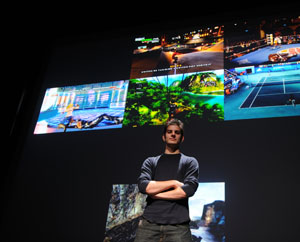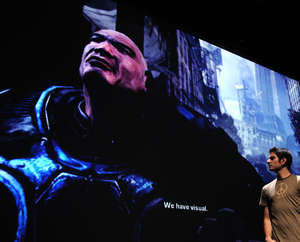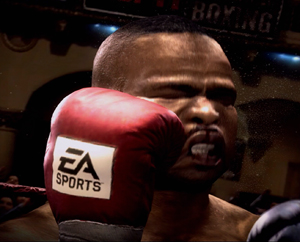UCSD Alumnus and Calit2 Staffer to Show Super-High-Definition, Hip Hop-Inspired Video at International Festival
Uncompressed 3.5-Minute Video’s 138 Gigabytes Equivalent to 1,656 Hours of YouTube Videos
San Diego, CA, June 3, 2008 -- The year 1985 was a momentous one for the arts and entertainment industry: The first Nintendo Entertainment System was released in U.S. stores, hip hop was in its early heyday, and the sci-fi flick "Back to the Future" was drawing huge crowds.
It was also the year UC San Diego alumnus Mike Toillion was born. Now, at the ripe old age of 23, Toillion has traveled back to the future himself, remixing elements from old-school hip hop culture and new-school video games to create a state-of-the-art 4K digital video that is beginning to draw attention from across the globe.
|
Toillion’s video, titled "Beatbox360," will make its international debut Aug. 4 at the grand opening in São Paolo of FILE, Brazil’s annual Electronic Language International Festival. The video was produced using 4K technology at the UCSD division of the California Institute for Telecommunications and Information Technology (Calit2), where Toillion has worked as an assistant media specialist since graduating from UCSD in 2007. The 4K digital cinema format offers four times the resolution of full HD, can be streamed live and is believed by some in the industry to be the next big thing in digital cinema production. This marks the first year that FILE will be showcasing 4K digital cinema.
The origins of Toillion’s short film go back to his days as an undergraduate student in UCSD’s Interdisciplinary Computing and the Arts (ICAM) program. While studying under Visual Arts lecturer and ICAM Coordinator Brett Stalbaum, Toillion learned about ‘machinima’, or the art of making movies with video games. Toillion’s first machinima project was called "Beatendo" and used video clips from the Super Nintendo game system to comprise a visual hip hop beat.
While a senior, Toillion was hired for a student position as an audio visual assistant at Calit2. It was there – with access to Calit2’s Sony SXRD 4K projector – that he decided to take his work to a new level.
"I felt like my position was very rare," he said. "I was one of the few students who had access to the 4K equipment. I didn’t know anything about HD, let alone 4K, before I started working at Calit2. So my interest was also ignited there."
Typically, 4K films are created in one of three ways: 1) With an expensive 4K camera; 2) with an 8-megapixel still camera; or 3) with computer rendering, the method used by Visual Arts professor and Calit2 artist-in-residence Sheldon Brown to create his "Scalable City" 4K video, which will also be shown at the Brazilian festival.
Toillion’s experiment with 4K technology takes a fourth approach and combines multiple low-resolution images to create a 4K rendition.The result is "Beatbox360," a portmanteau of Xbox 360 – the video game system he mined for visual and audio samples – and the term "visual beat."
"The cool thing about a visual beat is that it’s hard to say what takes precedence – sound or image," said Toillion, who graduated with an emphasis in visual arts and is also a drummer and composer. "It reminds you that, wow, those elements are really tied together. It’s also sort of a tie-in to the VJ-era that started to happen back in the ‘80s. This is a cool way to see music visualized right before you. This project puts them both at the forefront of the piece."
The end result is a high-energy, super high-definition "digital collage" of visual and corresponding audio clips from Xbox games such as "Gears of War" and "King Kong." The clips appear at various intervals throughout the video and are arranged in a grid format, starting in the center of what Toillion calls the "4K canvas" and moving to the outside edges when new clips are introduced. The video clips' corresponding audio tracks combine to form a rhythmic hip hop beat that serves as the soundtrack for the overall piece.
|
"I also tried to think of it in terms of a live musical performance as to where the sound would go in the room," he said. "This way, listening and watching become more of an active experience than a passive experience. "
And in some cases, even a sentimental experience.
"Sometimes, people seem to focus on something on the screen that triggers some sort of nostalgia for a video game they’ve played," he added.
Toillion embedded several tributes to hip hop culture within the piece, in particular, to KRS-One’s track '"South Bronx." He said he drew parallels between his work and the four components of hip hop -- the DJ, the MC, graffiti art and breakdancing – and tried to exhibit one aspect of each component in his work.
The audio samples in "Beatbox360" are reminiscent of a DJ’s turntable mix, for example, and the sound byte Toillion incorporated from the game "Blitz the League" ("Yeah , what you got, boy?") alludes to the quintessential hip hop MC, who boasts about his prowess on the mic.
Another reference to hip hop is the video’s climax, when the grid format gives way to a full-scale clip from "Fight Night: Round 3," which features a fighter getting knocked out in the ring. Toillion said he was alluding to the fact that "hip hop has gone through many deaths and many resurrections over the years." It has only been through remixing – making the old new again – that hip hop has continued to survive and reinvent itself. In turn, remixing has played a central role in Toillion’s project.
"My piece as a whole deals with remix at its core. I’m remixing different approaches with HD and 4K workflows. I’m remixing different media -- film, video games and music. And I’m remixing different art forms, both video art, found art and machinima."
In a sense, Toillion also remixed computer equipment – and lots of it. To create "Beatbox360", he used the HD component from an Xbox game system and converted it to high-definition multimedia interface (HDMI). He then recorded 93 samples from 27 different high-definition Xbox games, narrowing the clips down to a total of 36 samples for what would eventually amount to a 3 1/2 minute video.
He said one of the most difficult parts of the project was capturing the audio samples, since the second he hit "record," the audio would cut out on the game he was playing.
"I had to sort of trigger the sample in the game without hearing it," he said. "I tried to cast a really wide net of samples. With Super Nintendo, it was easier because the sounds were just blips and beeps. But in the newer video games, the sound is more ambient. I had to throw out some samples, because I couldn’t isolate enough sound."
Toillion’s next step was to use a Black Magic HDMI capture card to capture completely uncompressed HD. This process, which required several encodings, proved to be difficult, time-consuming and -- because of the high bit rate involved -- a danger to his computer equipment.
|
To cope with the demands of such a data-intensive project, Toillion had to build his computer from scratch. Under the tutelage of Calit2 systems integrator Qian Liu, Toillion learned how to construct a striped raid array by stringing together individual hard drives to make them faster. He said he also spent a lot of time in Internet forums, learning about HD and 4K technology, and "If I hit a wall, I kept researching until I could overcome it."
All in all, the project took Toillion about 8 months to complete, working mostly weekends while also holding down his full-time job at Calit2.
Toillion could be the youngest person anywhere to produce an entire 4K work. He attributes his success to his ability to apply widely available techniques to an uncommon medium.
"I was able to break into this new medium, which is dominated by big-budget Hollywood studios and production companies," he said. "This is similar to the way in which hip hop was born out of a lack of materials and resources.
"Scarcity and restriction can help foster creativity."
Related Links
Beatbox360 Video Presentation at Calit2 on YouTube
Download Beatbox360 in 1080p HD [Direct Download]
Beatbox360 Web site
Jettison High Productions
Media Contacts
Tiffany Fox, (858) 246-0353, tfox@ucsd.edu



